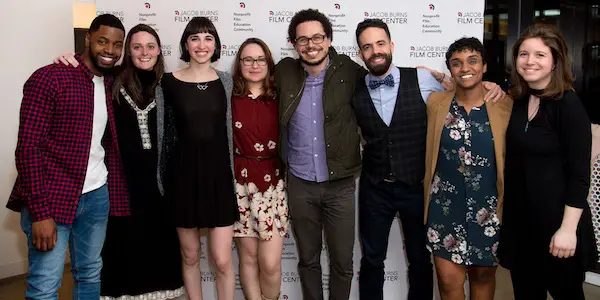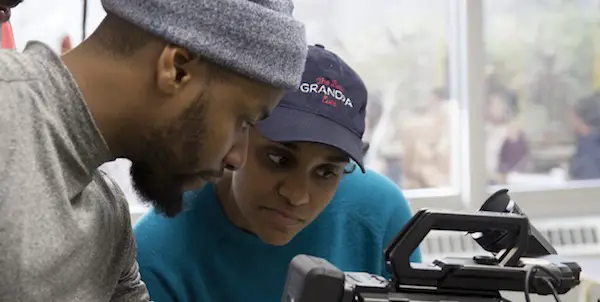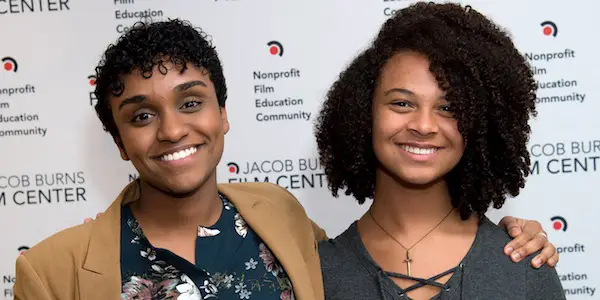Jacob Burns Film Center’s Creative Culture Program: An Experiment In Filmmaking & Interconnectedness

Sophia Cowley is a young writer, yogi, feminist and film…
If you have ever been to the Jacob Burns Film Center in Pleasantville, NY, you know that you will be ushered into a unique cinematic experience, made possible by its warm staff and exciting atmosphere. Over the years, the Jacob Burns Media Arts Lab, an adjunct of the Jacob Burns Film Center, has implemented many educational and artistic programs, solidifying its place as a cultural hub of Westchester County. The Lab’s most recent addition, called Creative Culture, aims to support rising talented artists through the hands-on “Lab Experience.”
Last week, I attended a showing of the incredible work put out by the Lab Experience’s pilot class. Over the course of about two hours, the audience and I dipped our toes into many realms, from the surreal fantasy worlds of virtual reality and stop-motion animation, to the corporeal dance sequences of visual poetry, to the “real-world” scenarios of documentary.
Human Connection
Each film possessed a certain vulnerability; many dealt with issues of humanity, interconnectedness and humility. For example, Nevada, the work of recent Sundance Ignite Fellow, Emily Ann Hoffman, tells the intimate story of a sexual encounter gone wrong. Through beautifully animated stop-motion and carefully articulated dialog, we see the plight of a modern couple resolved through sensitive language and a reflective inner experience.
Human connection, a core component of the collaborative artistic endeavor, strung these shorts together like an etheric cord. On one hand, this connection could be virtual, as communicated by Lucy Adams’ short, Good Game, a piece on internet and game addiction, or as made real by Alex Gonzalez’s moving VR project, Beyond The Mountain.
Furthermore, the connection could be tangible, even fundamental, as in Leah Galant’s Kitty And Ellen, a poignant, short documentary about two best friends who were Holocaust survivors. Relationships were key in the visually impressive shorts. As expressed by the playful, important narrative of Reweina Tessema’s Third Period, simple actions can sometimes leave the most lasting impact.
Esoteric relationships were equally important, as encompassed by the soulful, supernatural narrative of Kervin Marseille’s Aubade: The Sunrise and Stephaniya Vey’s airy music video, Paper Planes.

photo: Lynda Shenkman Curtis
While the theme of relationships existed within the films themselves, it became exceedingly clear as the night went on that these filmmakers could not have succeeded without each other. Most of the film credits overlapped: a co-director of one film was DP for the next and Gaffer for another.
Collective Collaboration
As Sean Weiner, director of Creative Culture puts it, “I believe deeply in the collective approach to filmmaking. We are all in it together. And if we are generous we can make one another better.” This generosity certainly came across in the class’s films. I was lucky enough to catch a few minutes with filmmakers Reweina Tessema and Kervin Marseille, who spoke with me about debuting their films and their experiences working in a collaborative, artistic environment.
“It’s nerve racking but it’s also very exciting,” Reweina Tessema, director of Third Period, told Film Inquiry. Like many of her classmates, this was Tessema’s first ever screening.

After graduating from SUNY Purchase, a NY State school known for its prestigious Film Production and Cinema Studies programs, Tessema began working as a TA at the Jacob Burns, following the guidance her professor and fellow Burns employee, Sean Weiner.
In the fall of 2015, Tessema received the Valentine & Clark Emerging Artist fellowship. She also teaches a course for high school students at the Jacob Burns Lab. The purpose behind her film Third Period is, in Tessema’s words, “to hopefully have an audience member see a memory from their childhood in it, and to laugh at themselves and laugh at what may have been a painful memory at the time.”
Tessema, along with the other Creative Culture filmmakers, worked tirelessly to finish their projects on time. In fact, some of the projects are still works-in-progress. One filmmaker noted that some nights the crew was up until 4AM, feverously editing.
Kervin Marseille, whose powerful short, entitled Aubade: The Sunrise, told Film Inquiry that his film begun exporting at 9:35 that morning. “I’m really excited to see everybody’s reaction for the first time,” he said. “I’m excited to see my reaction, too, because I haven’t watched it yet,” he added, smiling.
The crew worked back-to-back weekends to finish the film, exhibiting a work ethic that seemed to be essential to the Creative Culture collective. Marseille’s film centers on four dancers. “I knew what I wanted to see but I couldn’t choreograph,” he said. But the dance came together in an otherworldly kind of way. Marseille said he ended up teaching the dancers almost without meaning to, which came as a shock both to him and his co-director, William Leonard. (The two co-run a video production company called Paramount Chief, whose Vimeo you can find here.)
How To Get Involved
Thanks to the Jacob Burns, I was able to interview Sean Weiner (director of the Creative Culture program), who told me about his role in Creative Culture and how anyone can get involved. Below is our interview, via email.
Sophia Cowley, for Film Inquiry: Who or what initiated the founding of Creative Culture?
Sean Weiner: It came about organically in a few different ways. Most linearly, I took over leading and mentoring our Valentine & Clark Emerging Artist for local storytellers under 30. The one thing they always told me at the end of their fellowships was, “This was incredible but I wish there were other folks doing the same thing.” It was that longing for that senior thesis moment at the end of college when everyone has cut their teeth and built their skills and now we’re all peers working on high level projects.
So when the Jacob Burns Film Center did a strategic planning phase and reflected on how the org wanted to grow, we looked at how we could leverage that expressed need and our ongoing desire to be a local hub for filmmaking. What is so nice is that for our pilot class we were able to bring the former fellows that had expressed this need and give them the thing they had asked for.

What is your role in Creative Culture and the pilot class? Can you tell us a bit about the collaborative nature of the class?
In title, I am the Director of Creative Culture. What that amounts to is that I’m sort of a creative producer on each project. This means that I meet weekly (sometimes daily) with the makers to keep the project on schedule and gift any knowledge I have gained through experience as a filmmaker to their process. The input is sometimes creative and other times very objective and deadline driven. I work with each fellow from preproduction through completion.
Beyond that, the full group meets formally once a week for 3 hour sessions. During this time we do table reads of scripts, give critique on rough cuts, and talk about ways to strengthen and build a collaborative culture.
With this in mind, as a group, these makes do skill shares (which we call “superpower shares”) where they teach the group something they are skilled at (moodboarding, documentary ethics, color grading). We’ve also developed a feedback approach based on Liz Lerman’s Critical Response Theory that teaches us how to participate in constructive critiques.
Can anyone join the program? How can someone get involved with Creative Culture?
Applications are now open! Part of piloting this new program is exploring how to make it thrive and keep it sustainable. So for our first public launch we are offering two ways to get involved: Fellowships & the Lab Experience.
If you fit the requirements of a fellowship (Emerging Artist Fellows must be local and under 30, Woman Filmmaker Fellows must be women) you can apply for a fellowship that receives 24/7 access to the lab, its own private editing suite, and all the perks of the community/equipment/mentorship of Creative Culture.
If you don’t fit those requirements, you can apply to be a maker in Creative Culture, which means that you are part of the class and gain access to the lab during business hours and access to the community and mentorship. Right now, the Lab Experience is priced at $2500 for the semester (which is a real value as opposed to renting/funding a short out of pocket [usually around 10k at least]).
However, we will provide financial assistance and scholarships to applicants that need it and can demonstrate financial need. It is crucial that this opportunity be available to all types of people.
All of these opportunities are application-based, all folks apply with a short project idea (we simply don’t have the resources to lift up a feature) and a reel to demonstrate that they’d be successful in accomplishing their proposed project. We have a formal review of all applications and select the incoming class. Deadline for these opportunities is set for July 1. Starting the semester in September.
What is the next step for the filmmakers of the pilot class who just made their debuts?
The journey is not over yet! All seven of these makers will be with us through the end of June. During that time we will focus on how to get these incredible projects out there into the world and appreciated. Each maker will return in two weeks for a plan of how to best use the rest of their time here to prepare for the next step in their creative career.
For Lucy [Adams], that will be building a treatment around her incredible short documentary on Internet addiction that will allow that project to find the support/funding to be a very important feature film. For others, it’s beginning work on a new film or working with visiting distributors and fest curators to get these projects screened.
What’s important in Creative Culture is not being a place that rips the rug out from under the maker after they finish the film. We have been and will continue explore ways to help give legs to the work develop here and continue to be a resource for alum of the program.
Does Creative Culture sound like something you would be interested in?
For more information, visit burnsfilmcenter.org. And be sure to check out the entire pilot class, along with links to their personal websites, here.
Does content like this matter to you?
Become a Member and support film journalism. Unlock access to all of Film Inquiry`s great articles. Join a community of like-minded readers who are passionate about cinema - get access to our private members Network, give back to independent filmmakers, and more.
Sophia Cowley is a young writer, yogi, feminist and film enthusiast from NY. Her idols include Miranda July, David Lynch and Abraham Lincoln. She runs the blog www. isthisthereellife.wordpress.com.












